
The Park United Presbyterian Church is located at 14 Cortland Street in Highland Park, Michigan. It was built in 1910 as the Highland Park Presbyterian Church, listed on the National Register of Historic Places in 1982, and designated a Michigan State Historic Site in 1983. It is a member of The Presbyterian Church (U.S.A.), and continues to offer services.

The Greenville Presbyterian Church is located on NY 32 just north of its intersection with NY 81 in Greenville, New York, United States. Its three buildings on two acres were listed on the National Register of Historic Places (NRHP) in 1985.

Shoreham Congregational Church is a historic church on School Street in Shoreham, Vermont. Built in 1846 by a local master builder, it is one of the state's finest examples of ecclesiastical Greek Revival architecture, and also housed local town meetings for more than a century. It was listed on the National Register of Historic Places in 2001.
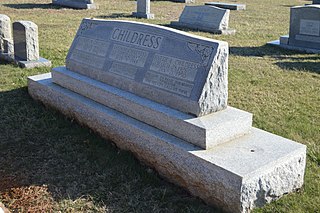
Robert "Bob" Walter Childress was a Presbyterian minister who was born in "The Hollow," now Ararat, Virginia, and grew up surrounded by the Primitive Baptist tradition. He became known throughout the Southern Appalachian region for his work to transform the region's culture of violence and promote basic education. He was also the founder of the famous "Rock Churches" of Floyd, Patrick and Carroll counties in Virginia.

Tompkins Corners United Methodist Church - now known as the Tompkins Corners Cultural Center - is located along Peekskill Hollow Road in Putnam Valley, New York, United States. It is a wooden frame structure built in the 1890s. In 1983 it was listed on the National Register of Historic Places, the only property exclusively in Putnam Valley to so far receive that distinction.

The First Presbyterian Church of Margaretville, now Margaretville New Kingston Presbyterian Church, is located on Orchard Street in Margaretville, New York, United States. It is an ornate wooden church built late in the 19th century.

Slate Mountain Presbyterian Church and Cemetery is a historic Presbyterian church and cemetery in Patrick County, Virginia. It was built in 1932, and is one of six "rock churches" founded by Bob Childress and built between 1919 and the early 1950s. The building consists of a one-story, gable-fronted rectangular form with a roughly square, Gothic Revival bell tower centered on the building's front elevation. The building was erected on a concrete block foundation, and has walls of light wood framing covered with a thick quartz and quartzite fieldstone exterior veneer.

Willis Presbyterian Church and Cemetery, also known as Grace Baptist Church, is a historic Presbyterian church and cemetery in Willis, Floyd County, Virginia. It was built in 1954, and is one of six "rock churches" founded by Bob Childress and built between 1919 and the early 1950s. The building consists of a one-story, gable-fronted rectangular form with a roughly square, Gothic Revival bell tower on the building's northeast corner. The building was erected on a poured concrete foundation, and has walls of light framing covered with a thick quartz and quartzite fieldstone exterior veneer.

Buffalo Mountain Presbyterian Church and Cemetery is a historic Presbyterian church located near Willis, Floyd County, Virginia. It was the first of the 5 "rock churches" founded by Bob Childress. It was built in 1929, and is a rock-faced frame building with a nave plan and front and rear transepts. The nave measures 33 feet wide and 80 feet long. It has a steeply-pitched gable roof covered with standing seam sheet metal. The contributing Cemetery has a continuous wall of mortared quartzitic fieldstones, matching the church exterior.
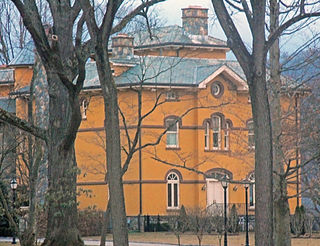
Rock Lawn is a historic house in Garrison, New York, United States. It was built in the mid-19th century from a design by architect Richard Upjohn. In 1982 it was listed on the National Register of Historic Places along with its carriage house, designed by Stanford White and built around 1880.

First Presbyterian Church is a Presbyterian Church (USA) church located in Muscatine, Iowa, United States. It, along with the attached Sunday School building, were listed on the National Register of Historic Places in 1977.
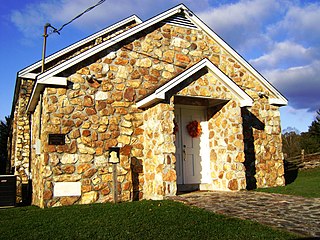
Bluemont Presbyterian Church and Cemetery is a historic Presbyterian church located near Fancy Gap, Patrick County, Virginia. It is one of the "rock churches" founded by Bob Childress. It was built between 1919 and 1950, and is a small frame church building faced in natural quartz and quartzite stone. It features a Gothic styled hexagonal bell tower. The rock facing was added to the frame building in 1946.

The First Presbyterian Church is a historic church at 213 Whittington Avenue in Hot Springs, Arkansas. It is a large stone building, designed by Charles L. Thompson in Late Gothic Revival style and built in 1907. It has a square tower with pronounced buttressing at the corners set on the right side of its front facade, and a lower tower at the left side, with a gabled entry section at the center. The entrance is set in a broad lancet-arched opening, and is topped in the gable by a three-part stained glass window. The main sanctuary space is set perpendicular to the main facade, with a large stained glass window set in a recessed round-arch panel at the end. An entrance into the tunnels underneath hot springs is also located here.
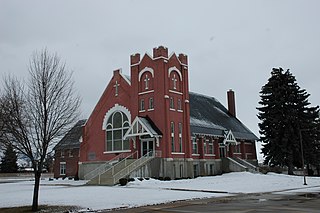
The Malad Second Ward Tabernacle is a tabernacle and meetinghouse of the Church of Jesus Christ of Latter-day Saints located in Malad City, Idaho. It is significant for its large scale and unorthodox adaptation of architectural styles, as well as its historical importance to Oneida County, which once was among the most populated counties in Idaho. It is, along with six other buildings in Oneida County, listed on the National Register of Historic Places.

Mayberry Presbyterian Church is a historic Presbyterian church at 1127 Mayberry Church Road in Meadows of Dan, Patrick County, Virginia. It is one of the "rock churches" founded by Bob Childress. It was built in 1925, and is a one-story frame church building faced in natural quartz and quartzite stone. It features Gothic styled lancet windows. The rock facing was added to the frame building in 1948.

Opequon Presbyterian Church is a historic Presbyterian church located near Winchester, in Frederick County, Virginia. It was built in 1897, and is a one-story, gable-roofed, random-rubble stone church. It features Gothic-arched colored-glass, one-over-one windows and a three-stage corner bell tower containing an entrance. Also on the property are four burying grounds with the oldest marked grave site dated to 1742.

The Thomas Hall House is a historic home located along the 3000 block of Tyler Road in Christiansburg, near Childress, Montgomery County, Virginia.
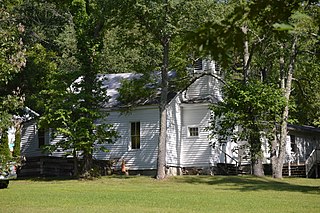
John Wesley Methodist Episcopal Church and Cemetery, also known as John Wesley United Methodist Church and Wesley Chapel, is a historic Methodist Episcopal church and cemetery located at West Warm Springs, Bath County, Virginia. It was built by former slaves in 1873, and is a one-story, front-gabled, log church, clad in weatherboard with a stone foundation. A frame vestibule with bell tower was added to the front of the church and a choir loft rear extension was added in 1923. In 1982 a one-story, frame Sunday School addition, clad in vinyl siding was built by volunteers and added to the southeast elevation. The church represents the lone built representation of the first decades of the African-American settlement at West Warm Springs.

Hebron Church is a mid-19th-century Lutheran church in Intermont, Hampshire County, in the U.S. state of West Virginia. Hebron Church was founded in 1786 by German settlers in the Cacapon River Valley, making it the first Lutheran church west of the Shenandoah Valley. The congregation worshiped in a log church, which initially served both Lutheran and Reformed denominations. Its congregation was originally German-speaking; the church's documents and religious services were in German until 1821, when records and sermons transitioned to English.

The St. Mary's Episcopal Church, on 1st St. in Emmett, Idaho, was listed on the National Register of Historic Places in 1980.
























